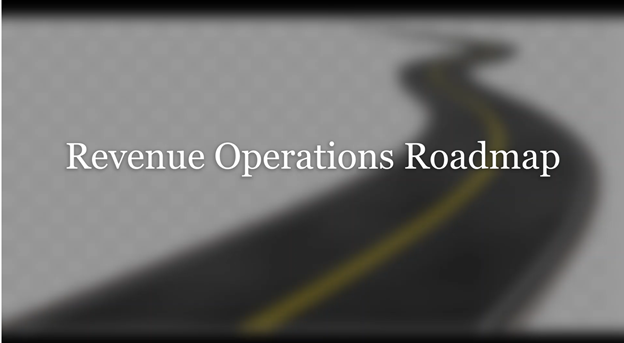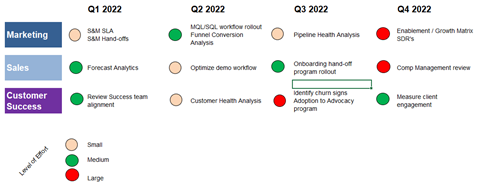 In my previous post on “Agents of Change,” we discussed using the W5 & H of change. Now we are going to review how we would use this methodology to build the Revenue Operations roadmap.
In my previous post on “Agents of Change,” we discussed using the W5 & H of change. Now we are going to review how we would use this methodology to build the Revenue Operations roadmap.
I want to begin this post with a quote by Antoine de Saint-Exupéry “A goal without a plan is just a wish.” Without a plan and/or a dependence on “gut feel,” you rely on a shotgun approach to your revenue “capture and keep.” Without a roadmap, your path to success is fraught with dangers, and you do not have a clear sense of direction and can make a wrong turn or fail to reach your destination.
It is important to note that this is not a project plan, which is great to have, but they provide a granular view of tasks and resources. The roadmap shows everyone the top-level strategy and direction and describes the high-level timelines.
Five things to consider
Simplicity – A roadmap will act as the visual tool. If you use excel or PowerPoint or an online tool such smartsheet or roadmunk, limit yourself to one tab/slide for each team, Marketing, Sales & Customer Success.
Easy to communicate – The roadmap design is simple; it is a straightforward way to display your focus on the revenue engine’s critical elements.
Collaboration – The roadmaps will require executives, sales, marketing, and customer success as part of the revenue team. And will also include your product team, finance, H.R., and legal. Remember that the roadmap describes multiple workstreams and owners. For your roadmap to be valuable, teams MUST collaborate to achieve the goals and objectives.
 Goal orientated – The roadmap is specific and focuses on critical activities and deliverables. The roadmap cuts through the minutiae and shows what matters.
Goal orientated – The roadmap is specific and focuses on critical activities and deliverables. The roadmap cuts through the minutiae and shows what matters.
Strategy and Prioritization – The roadmap delivers a clear scope of what you are focused on that produces a plan that is easy to understand and tied to deliverables.
A well thought out roadmap will include the who, what, where, when, why, and how. Use your mission and vision statements as your guidepost. Conduct a SWOT analysis and then apply S.M.A.R.T goals. Your RevOps roadmap should start and end with a growth mindset that focuses on closing the gaps along the buyer/customer journey.
First, begin by building a revenue operations productivity benchmark. This diagnostic tool uncovers your strengths and weaknesses in your revenue engine, Marketing / Sales / Customer Success. As part of this benchmark, you will start with an audit of the buyer/customer journey to identify any disconnect.
You need to review the G.T.M. plan currently in place and compare this to the overall company’s goals and objectives. This includes your marketing framework, your sales process, and customer onboarding, to name just a few.
With this completed, you will have identified the gaps in your revenue engine with probable solutions and plans that close the gaps.
 Your roadmap will define Who will lead each effort; it is critical to determine who is responsible for managing each element in your roadmap. The roadmap tells you What you will be doing along the way to reach each goal.
Your roadmap will define Who will lead each effort; it is critical to determine who is responsible for managing each element in your roadmap. The roadmap tells you What you will be doing along the way to reach each goal.
The road map also shapes, Where are we going and will define your objectives and goals. The roadmap will tell you When you will get to where you are going. It provides time-bound plans. The roadmap will describe, Why you are improving the experience you’re delivering to your buyers/customers.
Finally, the roadmap tells you How you know you are making progress. Your roadmap will include KPI’s that can measure your progress at each time marker. This way, you can understand if you are making progress towards achieving your goals.
Revenue Operations works across the business at both the macro-level as well as the micro-level. The roadmap will only cover the macro-level view. This view will focus on the strategic business objectives and inform your tactical program design and project plans, managing the resources to ensure that the outcomes align with the business’s needs.
Roadmaps vs. Project Plans
A detailed project plan is valuable, but as I said above, a detailed project plan will be too large and complicated and is not ideal for communicating the vision to all stakeholders. The critical difference is that roadmaps capture the actions, goals, and dates in a high-level and visually simple plan. Unlike Project plans, Roadmaps are not a ground-level view, rather the 50k view and act as a guidepost of the overall direction. Roadmaps do not replace project plans as they are not detailed enough.
When building the roadmap, do not get trapped into one-time documentation of your critical problems that you then “set-it-and-forget-it.” The roadmap is a strategic document that defines where you were and where you are going.
You will need to develop a monthly cadence to review and update the roadmap. What are the critical dependencies and metrics? Have they been achieved? Were they completed in the timeline you set?
The roadmap review shows if you passed the “gates” you set. You can easily communicate the current status and your KPI’s that show you delivering your improvement goals?
It is critical to the roadmap that your objectives are measurable and show where you started from and where you are going. You want to build the roadmap to evolve as you evaluate your current state. This review should enable data-focused decisions that positively impact both your customers and your revenue.
Here are the three key steps to begin:
- Describe your objectives and deliverable
- Assign the resource or functional groups responsible for tasks
- Set the timeline
The roadmap will include an outline of the critical activities in the order they need to be executed and the time required to complete. Often these objectives require the successful completion of the previous actions. You then can capture and communicate any critical roadblocks or risks.
By documenting your action plan, you can then communicate critical objectives to the workforce to obtain buy-in and support. Below is a sample of a roadmap
As a final note, the six things to always consider in your roadmap are:
Strategy – A defined set of operating principles that ensure planning, process, systems data, and KPIs aligned across marketing, sales, and customer success.
People – Alignment of the revenue teams around a single view of your business with each team’s participation in the revenue goals.
Process – The design, management, and tracking of cradle to grave revenue processes, including the automated and manual processes needed to blend the multiple connected revenue processes.
Data – What data sources will you use, and what is the quality of the data needed to manage and optimize end-to-end revenue processes.
Analysis – What are the agreed-upon activities and KPI’s that you will use to monitor and measure your success or set-backs across the revenue lifecycle.
Technology – The set of tools you use/need across the revenue engine to evaluate the value and R.O.I. of these for Revenue Operations execution.
Your roadmap is just that, a map that provides alignment, accountability, creditability, and trust across the entire revenue team. When shared across your organization, it allows everyone to understand the ultimate goal, as well as the steps needed to get there.
Leave a Reply